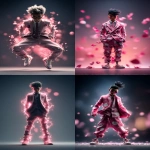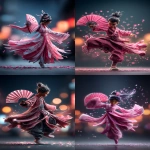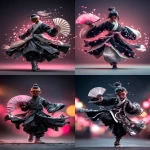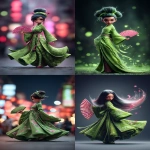Explore the Best AI Image Gallery

Beyond the Brushstroke: Wearable Tech as a New Creative Canvas
The intersection of technology and art has always been a fertile ground for innovation. From the advent of photography to the rise of digital media, each technological leap has presented artists with new tools and platforms to express their visions. Today, wearable technology stands at the forefront of this evolution, offering a revolutionary canvas for creative exploration.
Wearable devices, encompassing everything from smartwatches and AR glasses to haptic feedback suits, are no longer confined to practical applications. Artists are increasingly harnessing these technologies to blur the lines between the physical and digital realms, creating immersive experiences that engage all senses.
Sculpting Sound with Movement
One of the most compelling applications of wearable tech in art lies in its ability to translate movement into sound. Imagine a dancer adorned with sensors that capture their every gesture, transforming it into a symphony of ethereal melodies or pulsating rhythms. This sonic embodiment of movement opens up a world of possibilities for choreographers and composers, allowing them to create interactive performances where the audience becomes an integral part of the artistic experience.
Painting with Light and Data
Wearable AR glasses can transform the way we perceive our surroundings, overlaying digital elements onto the physical world. Artists are using these glasses to create interactive installations that respond to viewers movements, generating dynamic patterns of light and color. Furthermore, data collected from wearable sensors can be visualized in real-time, creating mesmerizing displays that reflect the collective energy and emotions of a gathering.
A Collaborative Canvas
Wearable tech also fosters collaboration in new and exciting ways. Imagine multiple artists wearing haptic feedback suits, each contributing to a shared artistic experience. They could sculpt virtual landscapes together, their movements influencing the form and texture of the environment, or they could collaboratively compose a piece of music, each artist adding their unique layer of sound.
Ethical Considerations: Navigating Uncharted Territory
As with any powerful technology, wearable tech in art raises important ethical considerations. Data privacy is paramount. Artists must ensure that personal data collected from wearables is handled responsibly and ethically. Additionally, questions arise regarding ownership and copyright when artistic creations are generated through the interaction of multiple users or AI algorithms.
Its crucial to establish clear guidelines and regulations that protect both artists and individuals using wearable technology in creative contexts.
The Future: A World Where Art is Immersive and Interactive
The convergence of wearable tech and art promises a future where creativity knows no bounds. Imagine immersive art installations that respond to viewers emotions, personalized artistic experiences tailored to individual preferences, or interactive performances that transcend the boundaries of physical space.
As technology continues to evolve, we can expect even more innovative applications of wearable tech in the creative realm. The canvas is expanding, and the possibilities are truly limitless.












](https://images.ai-img.art/thumbnails/150/e67bb6a0489412d97d9d0252632e8132941ade9f56e839595d1f378c63a12fbd.webp)
](https://images.ai-img.art/thumbnails/150/442d207e92f84c6386a509c068a9dde02e6042e74a70ea682db65416fab7f245.webp)













](https://images.ai-img.art/thumbnails/150/db9e5d51ea694bb6c2b1a57e1c8064658d934914e733d7bcaf4158da35a6a76f.webp)





















